| Name
|
Origin
|
Type
|
Number
|
Image
|
Notes
|
| Fixed Wing Aircraft
|
| Panavia Tornado
|
 Italy Italy
 Germany Germany
 United Kingdom United Kingdom
|
Multirole aircraft, strike aircraft
|
14
|
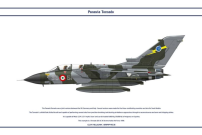
|
- Ground Attack: The Tornado is capable of carrying a wide range of weapons, including bombs, missiles, and cannon, making it effective for attacking ground targets such as enemy infrastructure, armored vehicles, and personnel.
- Deep Strike: With its low-level flying capability and long-range, the Tornado can penetrate deep into hostile territory to strike high-value targets such as enemy airfields, command and control centers, and strategic installations.
- Reconnaissance: Some variants of the Tornado are equipped with reconnaissance pods for gathering intelligence and conducting surveillance missions.
- Electronic Warfare: Specialized variants of the Tornado are equipped for electronic warfare roles, including suppression of enemy air defenses (SEAD) and electronic countermeasures (ECM) to disrupt enemy radar and communications.
|
| F-35A/B
|
 United States United States
|
Multirole fighter
|
12
|

|
- Air Superiority: The F-35 is designed to engage and defeat enemy aircraft in aerial combat. Its advanced sensors, stealth capabilities, and high maneuverability make it a potent platform for gaining air superiority.
- Ground Attack: Like the Panavia Tornado, the F-35 is equipped to conduct ground attack missions. It can deliver a wide range of precision-guided munitions, including bombs and missiles, against enemy ground targets such as vehicles, buildings, and fortifications.
- Close Air Support (CAS): The F-35 provides close air support to ground forces, offering rapid response and precision strikes against enemy targets in close proximity to friendly troops. Its advanced sensors and communication systems enable it to effectively coordinate with ground units.
- Reconnaissance: Some variants of the F-35 are equipped with advanced reconnaissance capabilities, allowing them to gather intelligence and surveillance information over enemy territory.
- Electronic Warfare (EW): The F-35 has electronic warfare capabilities to disrupt and counter enemy radar and communications systems. This includes the ability to jam enemy signals and provide protection for friendly aircraft.
- Strategic Strike: With its stealth capabilities and long-range precision weapons, the F-35 can conduct strategic strike missions against high-value targets deep within enemy territory.
|
| Eurofighter Typhoon
|
 Italy Italy
 Germany Germany
 United Kingdom United Kingdom
 Spain Spain
|
Multirole fighter, air superiority fighter
|
8
|
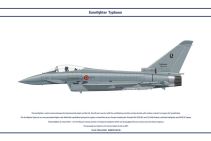
|
- Air Superiority: The Eurofighter Typhoon is designed to gain and maintain air superiority over the battlefield. It achieves this through its advanced aerodynamics, powerful engines, and sophisticated avionics systems, enabling it to engage and defeat enemy aircraft in aerial combat.
- Interception: The Typhoon is capable of intercepting and engaging hostile aircraft that pose a threat to airspace sovereignty or security. It can quickly respond to potential threats and intercept unauthorized or hostile aircraft entering controlled airspace.
- Ground Attack: Like the Panavia Tornado and the F-35, the Eurofighter Typhoon can conduct ground attack missions. It is equipped with a variety of air-to-ground munitions, including precision-guided bombs and missiles, enabling it to strike enemy ground targets such as vehicles, buildings, and fortifications with precision.
- Close Air Support (CAS): The Eurofighter Typhoon provides close air support to ground forces, offering rapid response and precision strikes against enemy targets in close proximity to friendly troops. Its advanced sensors and communication systems enable it to effectively coordinate with ground units.
- Reconnaissance: Some variants of the Eurofighter Typhoon are equipped with reconnaissance capabilities, allowing them to gather intelligence and surveillance information over enemy territory.
- Air Defense: The Eurofighter Typhoon is often tasked with air defense duties, protecting friendly airspace from potential threats such as enemy aircraft, drones, or cruise missiles. Its agility, speed, and advanced radar systems make it well-suited for this role.
|
| AMX
|
 Italy Italy
 Brazil Brazil
|
Ground-attack aircraft
|
27
|
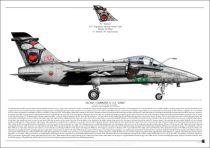
|
- Close Air Support (CAS): The AMX is designed to provide direct support to ground forces by engaging enemy targets in close proximity to friendly troops. It is equipped with a variety of weapons, including guns, bombs, and missiles, enabling it to strike enemy positions with precision.
- Ground Attack: The aircraft is optimized for attacking ground targets such as armored vehicles, artillery positions, bunkers, and other enemy installations. Its agility and versatility make it effective in conducting strikes against a wide range of targets.
- Interdiction: The AMX can conduct interdiction missions, disrupting enemy supply lines, transportation routes, and communication networks. It is capable of striking targets deep behind enemy lines to degrade their ability to conduct military operations.
- Reconnaissance: Some variants of the AMX are equipped with reconnaissance pods, allowing them to gather intelligence and surveillance information over enemy territory. These aircraft can provide valuable imagery and data to support military operations.
- Training: In addition to its combat roles, the AMX is also used for pilot training and proficiency development. It provides pilots with experience in operating a modern combat aircraft in various mission scenarios.
|
| MB-339
|
 Italy Italy
|
Trainer/Light Attack
|
15
|
|
- Training: The MB-339 is primarily used as a trainer aircraft for military pilots. It is often employed in basic and advanced training programs for jet pilots, providing them with experience in handling jet-powered aircraft before moving on to more advanced fighter or attack aircraft.
- Advanced Training: Beyond basic flight training, the MB-339 is also utilized for advanced training, including instrument flying, formation flying, tactical maneuvers, and weapons employment. It helps pilots develop the skills necessary for operating high-performance combat aircraft.
|
| MQ-9
|
 United States United States
|
Remote piloted aircraft/unmanned combat aerial vehicle
|
2
|
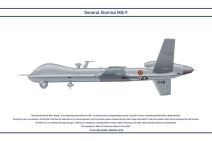
|
The MQ-1 Predator is an unmanned aerial vehicle (UAV) primarily used for surveillance, reconnaissance, and targeted airstrikes. Developed by General Atomics Aeronautical Systems, the MQ-1 has been employed by the United States military and other countries for various missions, including intelligence gathering, tracking of targets, and conducting precision strikes against enemy personnel and infrastructure. It played a significant role in military operations in Afghanistan, Iraq, and other theaters of conflict.
|
| C-27J
|
 Italy Italy
|
Military transport aircraft
|
1
|

|
- Tactical Airlift: The primary role of the C-27J is to transport troops, equipment, and supplies to and from locations that may not be accessible by larger transport aircraft. It can operate from short, unprepared airstrips, making it suitable for delivering cargo and personnel to remote or austere locations.
- Cargo Transport: The aircraft is capable of carrying a wide range of cargo, including vehicles, palletized cargo, and bulk supplies. Its cargo capacity and versatility make it valuable for logistics support in military operations.
- Aeromedical Evacuation: The C-27J can be configured to serve as a medical evacuation (medevac) aircraft, transporting wounded or injured personnel from the battlefield to medical facilities for treatment.
- Paratroop Operations: The aircraft can perform airborne operations, including the delivery of paratroopers and equipment for airborne assault missions.
- Search and Rescue (SAR): In some configurations, the C-27J can be equipped for search and rescue missions, aiding in locating and rescuing personnel in distress, particularly in maritime environments.
- Humanitarian Relief: The C-27J is suitable for humanitarian missions, delivering aid supplies, conducting medical evacuations, and supporting disaster relief efforts in regions affected by natural disasters or other emergencies.
|
| C-130J
|
 United States United States
|
Tactical airlifter
|
5
|
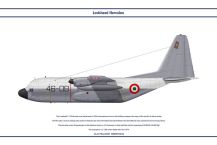
|
- Tactical Airlift: The primary role of the C-130 is to transport troops, equipment, and supplies to and from short, unprepared airstrips in austere environments. It can operate from rough terrain, making it valuable for delivering cargo and personnel to remote locations.
- Cargo Transport: The C-130 can carry a variety of cargo, including vehicles, palletized cargo, and bulk supplies. Its large cargo hold and rear loading ramp make it adaptable for transporting oversized cargo or a combination of passengers and cargo.
- Aeromedical Evacuation: The aircraft can be configured as a medical evacuation (medevac) aircraft to transport wounded or injured personnel from the battlefield or disaster areas to medical facilities for treatment.
- Paratroop Operations: The C-130 is capable of performing airborne operations, including the delivery of paratroopers and equipment for airborne assault missions.
- Air-to-Air Refueling: Some variants of the C-130, such as the KC-130, are equipped with aerial refueling capabilities, allowing them to refuel other aircraft in flight.
- Special Operations: Modified versions of the C-130, such as the AC-130 gunship, are used for special operations missions, including close air support, air interdiction, and armed reconnaissance.
|
| KC-130J
|
 United States United States
|
Tanker / Transport, Overwatch / Ground support
|
11
|
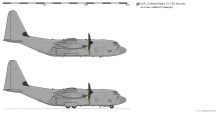
|
- Air-to-Air Refueling: The primary role of the KC-130J is to provide in-flight refueling capability to other aircraft, including fighter jets, helicopters, and other large aircraft. It extends the range and endurance of these aircraft by transferring fuel to them while in flight.
- Transport and Cargo: Like its base model, the KC-130J can also be used for transporting troops, equipment, and cargo. It retains the capability to carry cargo internally and/or on external pallets while still maintaining its aerial refueling capabilities.
|
| Rotary Wing Aircraft
|
| HH101
|
 Italy Italy
|
Maritime Patrol
|
9
|
|
Originally bought from Russia back in 2020, now switched to patrol usage. The T1 variant is a Corkonian variant of the Mil-24 which replaces the front gun with a spotlight. The T1 is not armed.
|
| HH139
|
 Italy Italy
|
Maritime Patrol/Rescue
|
4
|
|
Used solely for patrol and maritime rescue operations
|
| VH139
|
 Italy Italy
|
Maritime Patrol/Trainer
|
5
|
|
Used for training purposes however 1 is reserved for maritime patrol operations.
|
| NH500
|
 Italy Italy
|
Maritime Patrol/Trainer
|
23
|
|
|
| AW 139
|
 Italy Italy
|
Maritime Patrol/Trainer/Rescue/Utility
|
26
|

|
|







